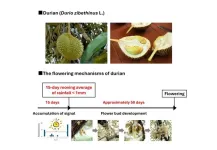Cryptographic protocol enables secure data sharing in the floating wind energy sector
This breakthrough seeks to foster collaboration between industry and academia, driving innovation in floating wind technologies.
2024-12-23
(Press-News.org)
Floating wind power offers enormous potential for deepwater offshore energy development. However, the management and secure exchange of data between stakeholders represents a key challenge for its evolution. A new cryptographic framework, proposed by researchers Claudia Bartoli (IMDEA Software) and Irene Rivera-Arreba (Norwegian University of Science and Technology, NTNU), presented at WindTech 2024 Conference, tries to solve this problem with a data sharing scheme that guarantees data integrity without compromising privacy. This breakthrough seeks to foster collaboration between industries and academia, driving innovation in floating wind technologies.
Context
Floating wind power is positioned as a promising frontier in the renewable energy sector, enabling the expansion of offshore wind power to areas of greater depth. To harness this potential, it is essential to share reliable data between parties such as companies and academics.
Access to datasets is crucial at all stages of development, from site selection to maintenance. In addition, sharing data fosters innovation, attracts investment and strengthens trust among stakeholders. However, handling large volumes of data and protecting intellectual property pose significant challenges.
The current approach relies on data certified by certification bodies (Certification Body), but these often lack critical details to optimize system performance. In response, the researchers have described a cryptographic protocol that enables the secure exchange of critical data, ensuring privacy and integrity through advanced tools such as zero-knowledge proofs.
The study
The protocol proposed by Bartoli and Rivera-Arreba has been designed to facilitate interactions between the various parties involved in offshore wind energy development. It has the potential to transform data sharing in the wind energy sector, improving collaboration between industry and academia since it ensures data integrity between parties without disclosing additional information. With the implementation of this protocol, “Through the use of techniques such as Multi Party Computation (MPC), this approach allows the analysis of encrypted data, ensuring the confidentiality of the information while sharing the results obtained by such analysis” assures Claudia, lead researcher of the article.
In addition, the system incorporates cryptographic signatures and succinct commitment schemes to reduce costs and facilitate the management of large databases. These innovations open up new possibilities to overcome current limitations in data availability without compromising data privacy.
Conclusion
The implementation of this cryptographic protocol could mark a step forward in the development of floating wind power. By enabling the confidential exchange of data, it fosters innovation and contributes to bridging the gap between privacy and availability. This breakthrough represents a promising solution to address technological and regulatory challenges on the road to a sustainable future in the renewable energy sector and paves the way for future research in this regard.
END
[Attachments] See images for this press release:

ELSE PRESS RELEASES FROM THIS DATE:
2024-12-23
In a recent analysis of data from more than a dozen studies, coffee and tea consumption was linked with lower risks of developing head and neck cancer, including cancers of the mouth and throat. The findings are published by Wiley online in CANCER, a peer-reviewed journal of the American Cancer Society.
Head and neck cancer is the seventh most common cancer worldwide, and rates are rising in low- and middle-income countries. Many studies have assessed whether drinking coffee or tea is associated with head and neck cancer, with inconsistent results.
To provide additional insight, investigators examined data from 14 studies by different scientists associated with the International Head and ...
2024-12-23
Age-related macular degeneration (AMD) is the leading cause of vision loss in individuals over 65, characterized by abnormal changes in the macular, resulting in reduced vision and distorted objects. Dry AMD accounts for 90% of all AMD cases, with relatively mild vision impairment; however, approximately 30% progress to the severe vision loss associated with wet AMD within 10 years. The only FDA-approved treatments for dry AMD as of 2023 are two injectable drugs, which are limited by concerns over complications from intravitreal injections and modest ...
2024-12-21
Tokyo, Japan – Researchers from Tokyo Metropolitan University have discovered that around 15 days of dry weather can trigger the flowering of durian. Observations of 110 durian plants revealed that flowering occurred around 50 days after an approximately 15-day dry spell, independent of whether the plant was grafted or grown from a seed. The team’s work might not only impact the production of a valuable agricultural asset but deepen our understanding of tropical ecosystems.
Known in many countries as the “king of fruits,” the durian is known for its distinctive strong odor, large size, ...
2024-12-21
As NASA’s Europa Clipper embarks on its historic journey to Jupiter’s icy moon, Europa, Dr. Matt Powell-Palm, a faculty member at Texas A&M University’s J. Mike Walker ‘66 Department of Mechanical Engineering, has unveiled groundbreaking research that could transform our understanding of icy ocean worlds across the solar system. The study published in Nature Communications, co-authored with planetary scientist Dr. Baptiste Journaux of the University of Washington, introduces a novel thermodynamic concept called the “centotectic” and investigates the stability of liquids in extreme conditions - critical ...
2024-12-21
In the holiday movie The Grinch, makeup artists are reported to have spent several hours each day encasing Jim Carrey’s face with prosthetics to create the iconic grumpy, green-furred creature. Such elaborate prosthetics, often made possible by materials like silicone rubbers, may have now found an unexpected yet beneficial biomedical engineering application, according to a new study from Texas A&M University.
Published in the journal Scientific Reports, researchers have created realistic, skin-like replicas made of Ecoflex, a type of silicone rubber that can potentially serve as a platform to evaluate risks of bacterial infections from ...
2024-12-20
A research team co-led by a physician-scientist at the University of Arizona College of Medicine – Tucson’s Sarver Heart Center found that a subset of artificial heart patients can regenerate heart muscle, which may open the door to new ways to treat and perhaps someday cure heart failure. The results were published in the journal Circulation.
According to the Centers for Disease Control and Prevention, heart failure affects nearly 7 million U.S. adults and is responsible for 14% of deaths per ...
2024-12-20
In 2022 alone, over 20 million people were diagnosed with cancer, and nearly 10 million died from the disease, according to the World Health Organization. While the reaches of cancer are massive, the answer to more effective treatments may be hidden within a microscopic cell.
Led by Texas A&M University graduate students Samere Zade of the biomedical engineering department and Ting-Ching Wang of the chemical engineering department, an article released by the Lele Lab has uncovered new details about the mechanism behind cancer progression.
Published in Nature Communications, the article ...
2024-12-20
Researchers at Rice University have made a meaningful advance in the simulation of molecular electron transfer — a fundamental process underpinning countless physical, chemical and biological processes. The study, published in Science Advances, details the use of a trapped-ion quantum simulator to model electron transfer dynamics with unprecedented tunability, unlocking new opportunities for scientific exploration in fields ranging from molecular electronics to photosynthesis.
Electron transfer, critical to processes such as cellular respiration and energy harvesting ...
2024-12-20
HOUSTON, Dec. 20, 2024 –While lithium-ion batteries have been the go-to technology for everything from smartphones and laptops to electric cars, there are growing concerns about the future because lithium is relatively scarce, expensive and difficult to source, and may soon be at risk due to geopolitical considerations. Scientists around the world are working to create viable alternatives.
An international team of interdisciplinary researchers, including the Canepa Research Laboratory at the University of Houston, has developed a new type of material for sodium-ion batteries that could ...
2024-12-20
Passive interfaces, such as light switches or doorknobs, refer to hardware that can store energy, but the energy can only be used for the purpose it was intended. However, research is imagining new ways for that energy to be harvested and adapted — turning your doorknob could power your alarm system or opening your freezer could turn on your kitchen light.
By integrating smart capabilities such as sensing and energy harvesting, Dr. Jeeeun Kim is transforming passive interfaces into adaptive interfaces, altering hardware to be used ...
LAST 30 PRESS RELEASES:
[Press-News.org] Cryptographic protocol enables secure data sharing in the floating wind energy sector
This breakthrough seeks to foster collaboration between industry and academia, driving innovation in floating wind technologies.








